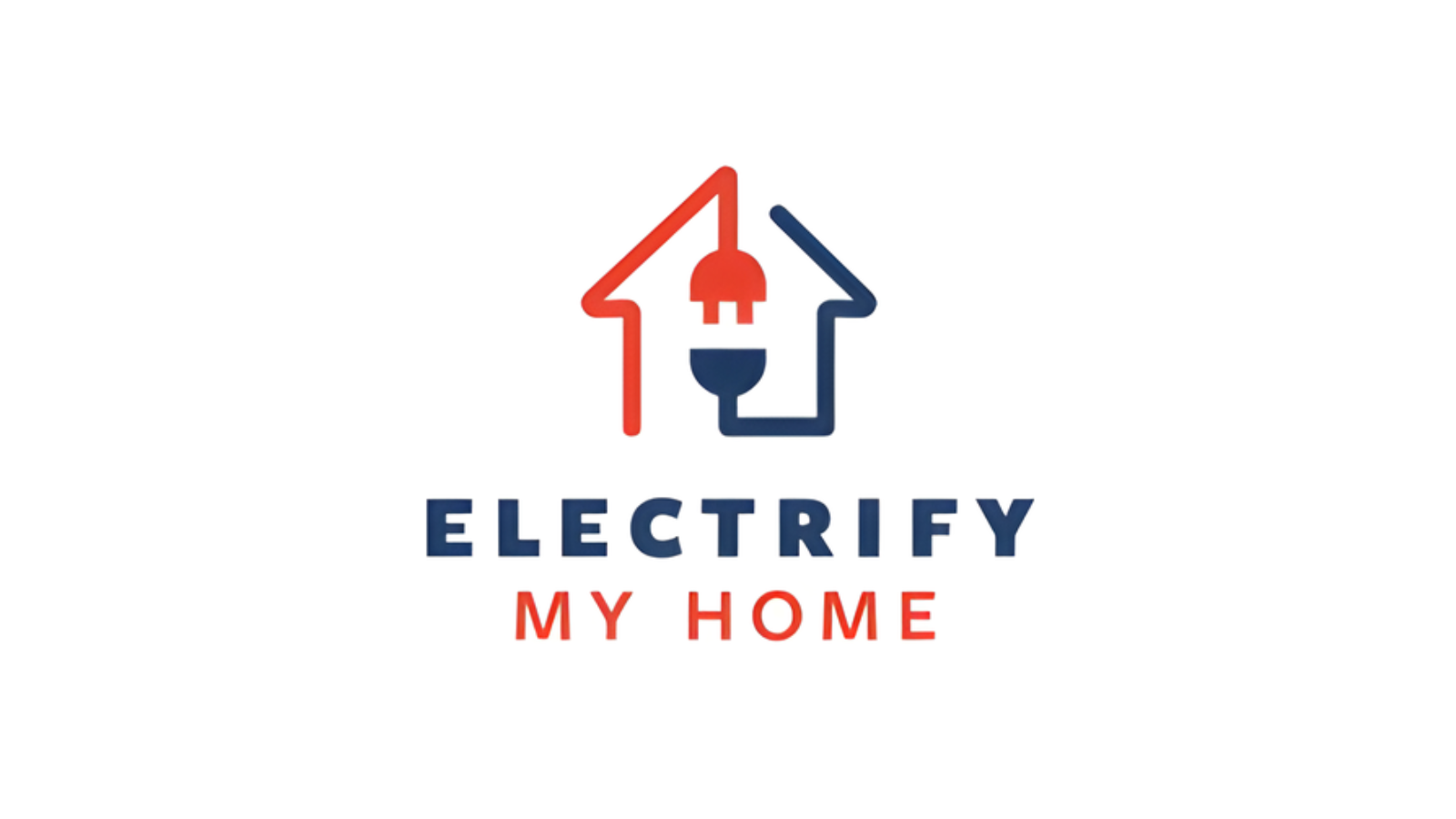Stop Competing on Price, Start Winning on Trust: The Heat Pump Business Model Matrix
 Amply
·
7 minute read
Amply
·
7 minute read
Selling heat pumps used to be easier.
We know you feel it. The heat pump gold rush is here. Rebates are (still) flowing, homeowners know the technology, but competition has exploded, so you’re no longer in a niche market.
On top of your usual competitors, now you're bidding against every electrician with a refrigeration license hanging a heat pump shingle. Private equity rollups are spending 5-10x your budget on ads. And good technicians are leaving those PE rollups to undercut them on price as solo operators.
You’re not the cheapest, you’re not the fastest, and you’re not a boutique heat pump “artisan.” You run a solid, independent, local business. You’ve got good people and a good reputation. And you deliver value to your customers.
But despite those assets, every lead now feels like a knife fight, and you’re pulled in too many directions just to compete in this intensifying landscape.
Most contractors we meet at Amply are just like you, caught in the middle of an industry changing faster than ever.
You know you need to stand out, but what’s the best way to do that and still grow sustainably over the long haul?
Amply’s Heat Pump Business Model Matrix
After thousands of conversations with contractors and interviews with the best-of-the best on our Heat Pump Podcast, we’ve learned there are only two ways to win outside of price:
- Expertise – Your HVAC / building science knowledge. Your craftsmanship. Your understanding of how to design, install, and optimize systems so they perform great for 15+ years.
- Process – The systems, tools, and customer touchpoints that smoothly, efficiently, and delightfully move your customers from lead → quote → install → loyal repeat customer.
Map expertise on one axis and process on the other, and you get a four-quadrant matrix, with each quadrant representing a different business model and type of HVAC contractor.
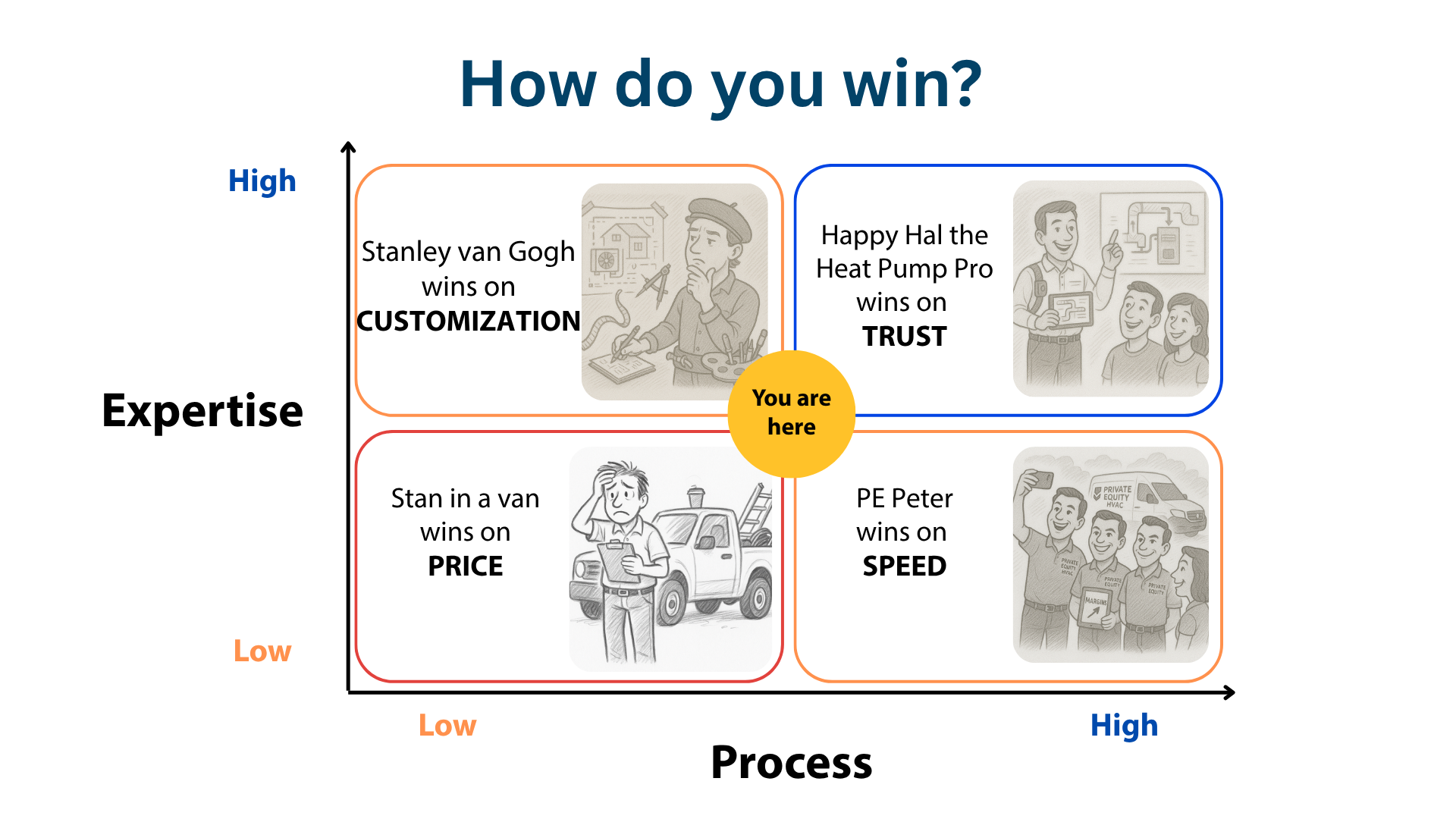
Most likely, you’re smack dab in the middle of this matrix, surrounded on all sides. You’ll need to choose a path forward, but to do so, you’ll first need to better understand each business model, the types of contractors in each, and how to win against them.
Business Model 1: Stan in a Van
Low Expertise, Low Process
Key Differentiator: PRICE
Stan is a one-man shop. His expertise is limited and his processes are rough around the edges. Handwritten quotes, slow response times, and no real sales system.
However, he keeps his overhead low, allowing him to win jobs by being the cheapest option in town. For a homeowner who just wants the lowest possible price, Stan is appealing.
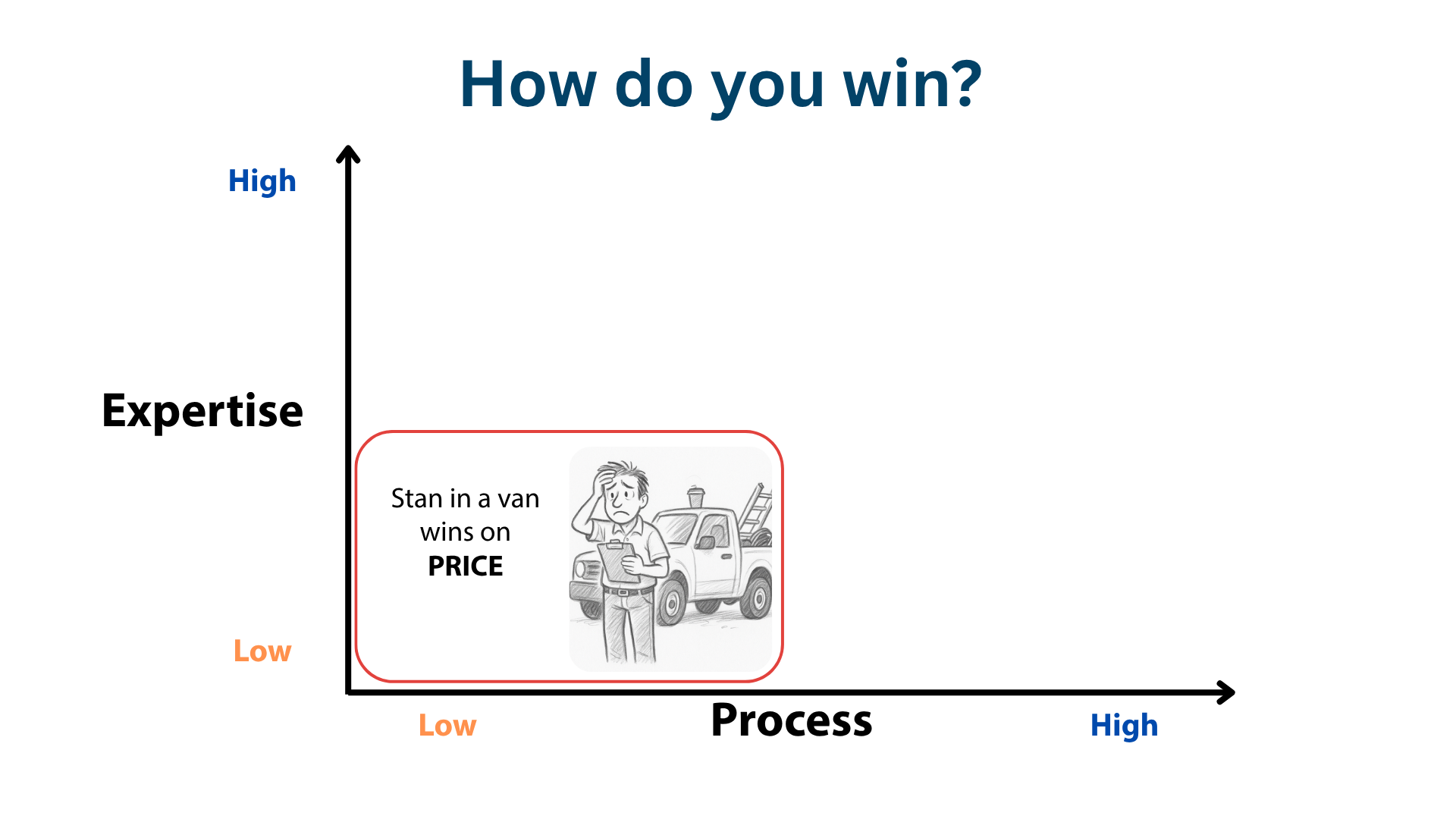
If you’re in the middle, you’ll constantly bump into Stans undercutting your bids. You might have been a Stan yourself when you first started out in the industry.
But nobody wants to live here for long. Stan can survive, but usually with razor-thin margins (if he isn’t inadvertently bidding jobs at a loss…), a poor reputation (with expensive callbacks), and no exit plan or attractive business to pass on when it’s time to retire.
We think there are more sustainable, fulfilling, and fun ways to win.
Business Model 2: Stanley van Gogh, the HVAC artist
High Expertise, Low process
Key Differentiator: CUSTOMIZATION
Stanley van Gogh has mastered system design. He knows Manual J, S, and D. His proposals are comprehensive – with detailed analysis, envelope improvements, properly sized equipment, duct modifications, and ventilation upgrades. His tickets run bigger because he's delivering uniquely tailored solutions, not just swapping boxes.
He’s a heat pump artisan.
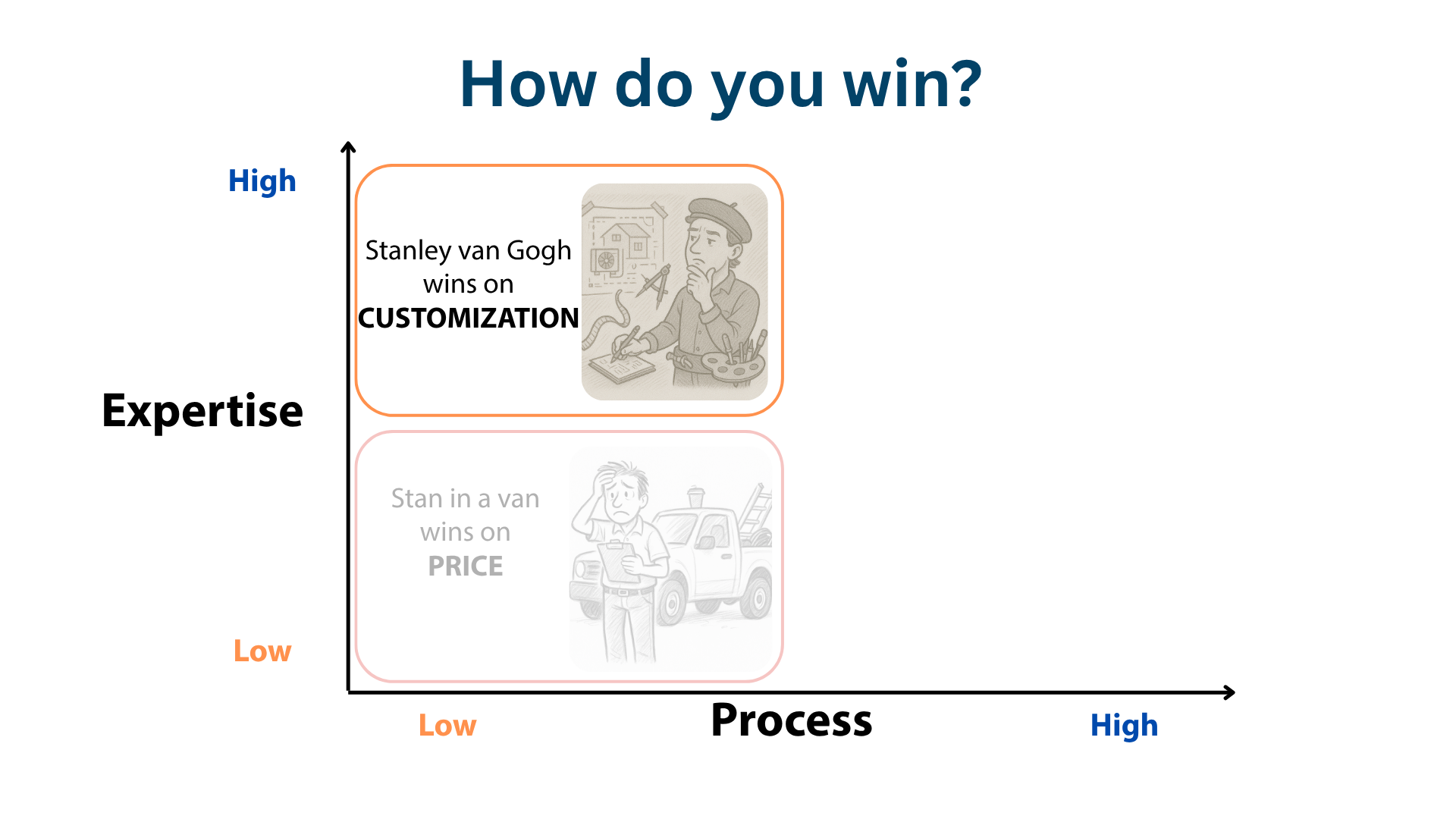
If you’ve invested in expertise but haven’t nailed down your process, you might feel a lot like Stanley. You design great systems, but your proposals take too long to pull together, so you often lose to the quicker bidder. Without process, expertise can become a liability.
If he doesn’t change anything, then Stanley stays boutique. He runs a premium solo operation doing 2-5 jobs a month at high margins. His expertise protects him, but he lives and dies by word of mouth. He has little opportunity for growth, and his exit options are minimal.
That’s not a terrible outcome, but Stanley could be so much more.
Business Model 3: P.E. Peter
Low Expertise, High Process
Key Differentiator: SPEED
Over the last 10 years, P.E. Peter and other Private Equity rollups have emerged as a major force in the HVAC market.
They used to be family-owned businesses. But now they’ve replaced management and win with huge marketing budgets and technology stacks that prioritize speed above all else. “Service in hours, not days”, they promise. For emergency replacements, that’s compelling.
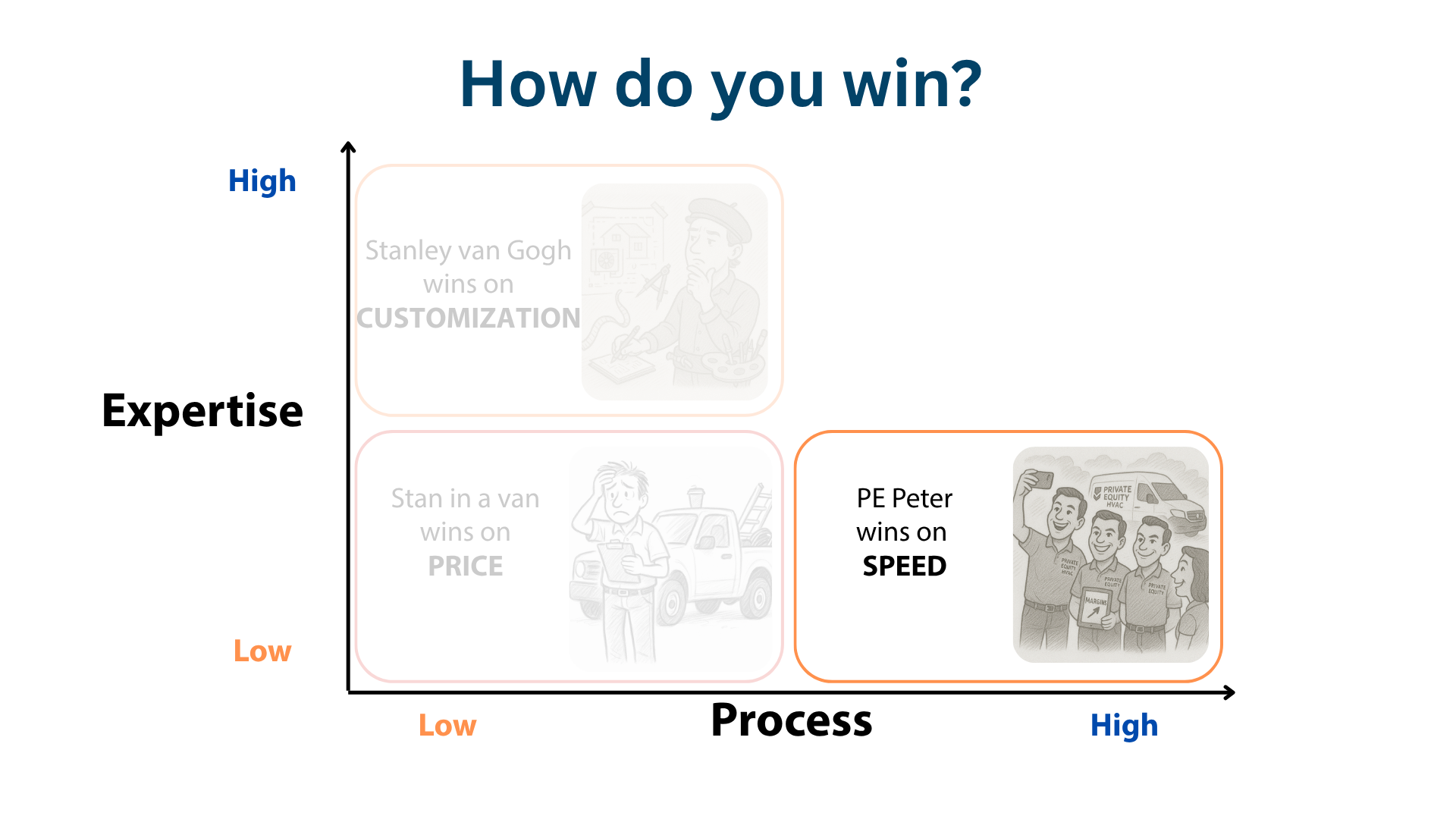
From the middle, it’s easy to feel steamrolled by PE-backed competitors. You can’t outspend them on ads or hire a big IT team to match their fancy speed-to-lead experience. And when a PE firm waves a big check in your face, it might be hard to ignore it (especially if your kids don’t want anything to do with your business).
But P.E. Peter’s speed is also his Achilles heel. He has to be fast because Private Equity investors demand huge profit margins. Upgrading the team’s expertise is expensive and time-consuming. And in the world ruled by this quarter’s results, a fast box swap will always have a better near-term return than thoughtful envelope improvements or tricky heat pump conversions. So P.E. Peter relies on speed because he has no other choice.
Of the three business models we’ve discussed so far, this one is the hardest to escape once you’re in it.
So P.E. Peter will likely stay right where he is. But is private equity a sustainable, long-term option?
Nobody really knows, but it’s gonna be fascinating to watch (especially based on what’s happening in the PE-owned HVAC market today).
Business Model 4: Happy Hal
High Expertise, High Process
Key Differentiator: TRUST
Happy Hal has mastered both expertise and process. He’s moved beyond technical competence and built a company with a mission to do heat pumps right and focus on whole-home performance.
This mission is Hal’s competitive advantage and empowers him to:
- Attract incredible employees who believe in the work they do every day
- Invest heavily in training (because his reputation depends on exceptional design AND execution)
- Turn away jobs that don't fit the company’s standards, because he’s building something bigger than this quarter's revenue
Companies in this quadrant win on Trust, and they feel fundamentally different.
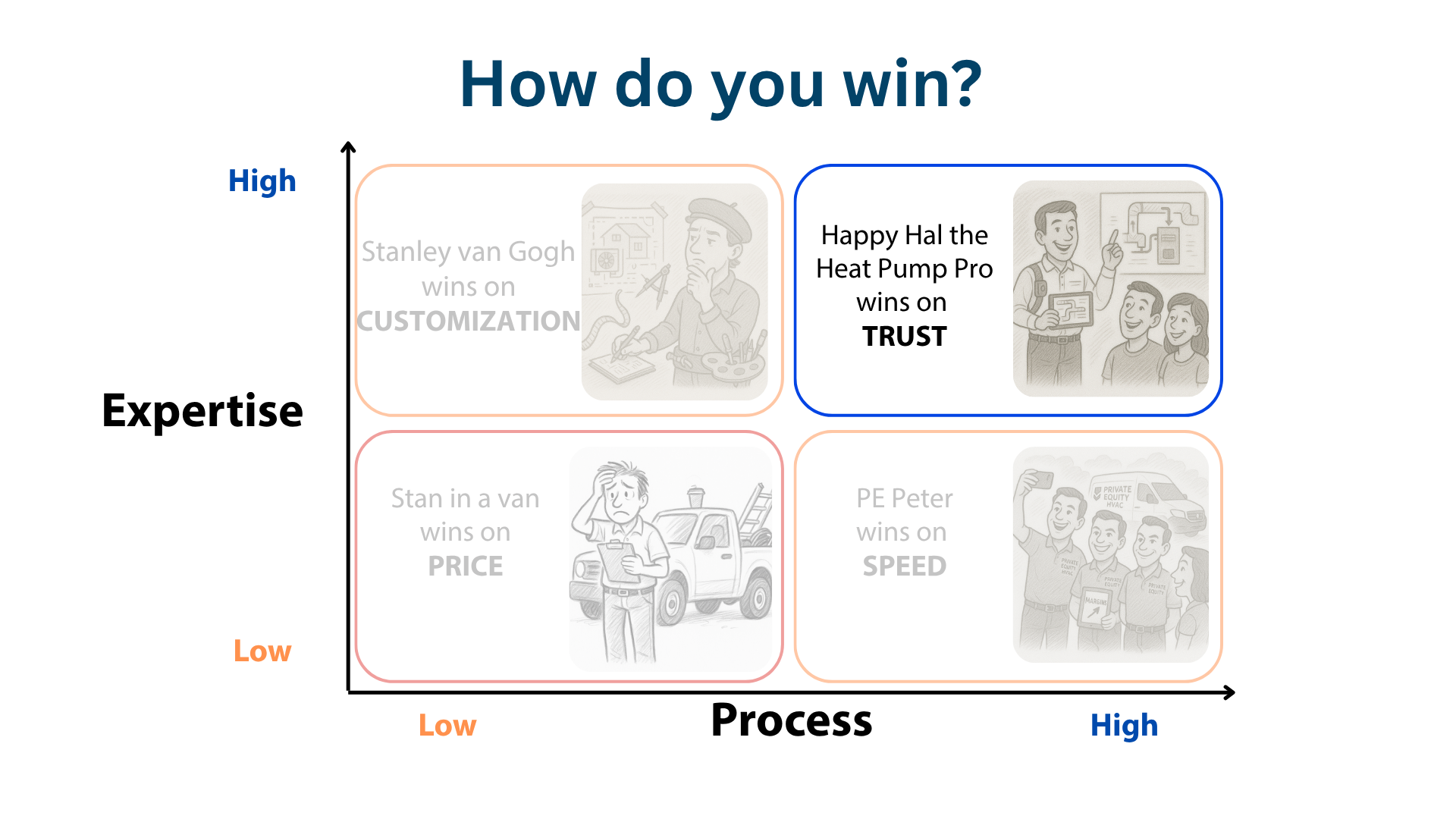
Customers trust that they'll get the right system, installed correctly, backed by people who care about the outcome, and who will still be in business 5, 10, 15 or 20+ years down the road.
For Happy Hal, Trust delivers:
- Higher margins without price wars
- Lower customer acquisition costs (referrals and repeat business)
- Fewer callbacks and warranty headaches
- A team that actually wants to work for you
- A model for success that his business can sustain long after he’s retired
Where Are You in This Matrix?
If you’re like most of the contractors we talk to, you’re what we would call a “solid independent business.” You have solid expertise and solid processes and you run a good company.
But you haven't yet committed to any particular business model, so you end up smack dab in the middle – competing in all directions and trying to be everything to everyone.
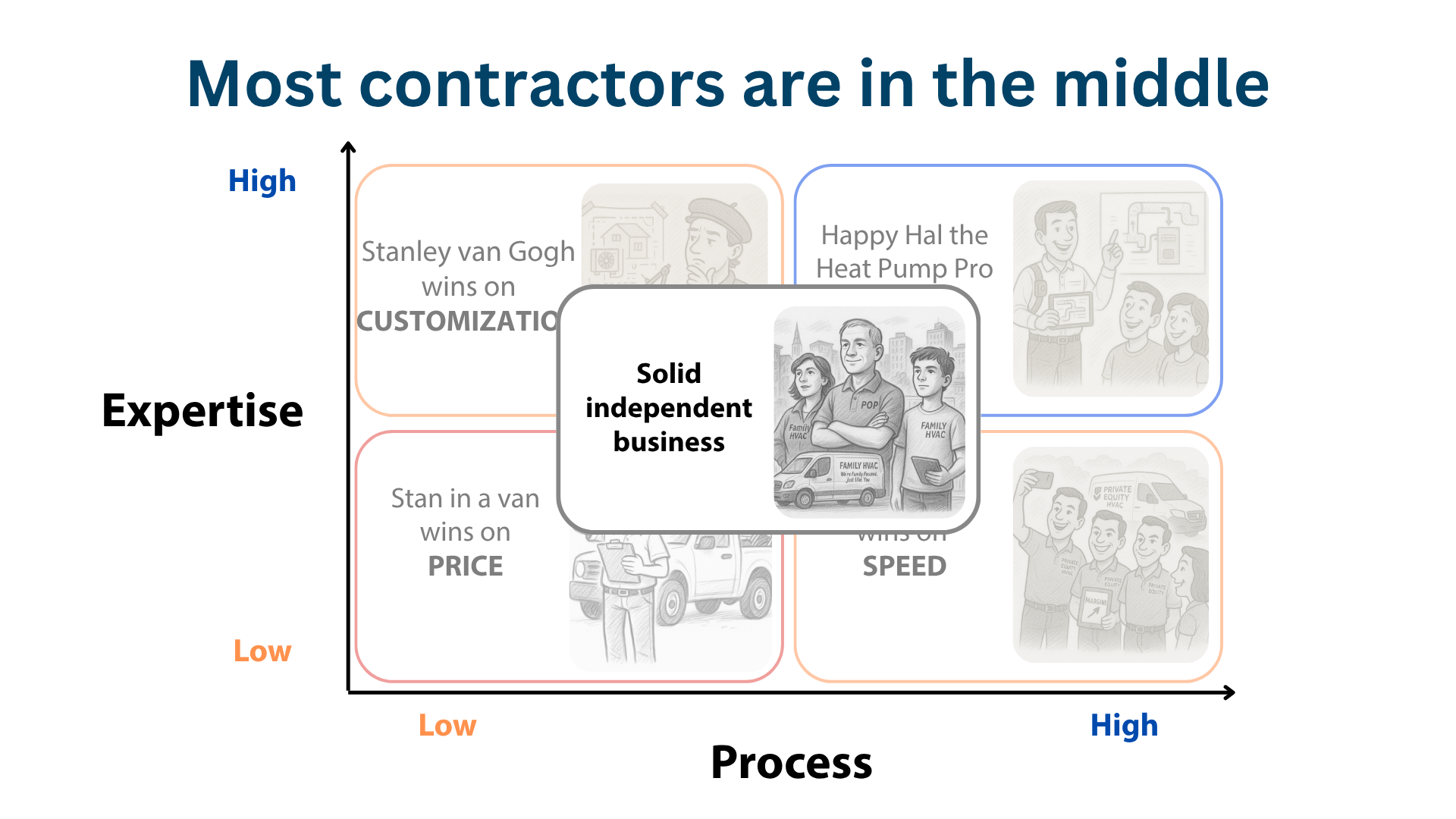
- You likely offer “general” HVAC services (or the trifecta of HVAC, plumbing, and electrical).
- You chase every lead and try to win with a good customer experience and strong reputation.
- But you end up competing on price more than you want to because you’re not different enough in the customer’s mind.
It’s time to differentiate and choose a business model that makes winning easier.
One thing is obvious, after speaking with and getting to know hundreds of you better: the happiest, most successful contractors are consistently winning on Trust.
And while not every contractor wins with Trust in the same way, over the years we’ve developed a concise list of the most common practices a Trusted contractor follows.
The Trust Checklist: Your Path to Long Term Success
We created The Trust Checklist to make this transition easier. It’s a simple, one-page document that plainly lays out the key elements that define a Trusted contractor.
The Trust Checklist makes the path out of the middle clearer. You can use it in two ways:
- As a self-assessment to see where you already stand out
- As a roadmap to decide what to work on next
The more of the boxes you check off, the more firmly you’ve committed yourself to winning on Trust. We’ve broken the Trust Checklist up into two primary categories:
1. Expertise: Build Your Knowledge
Trust is built on doing the work right. That means mastering load calculations, understanding the building envelope, and seeing the home as a system.
The good news is that you’re likely already partway there. Most contractors we talk to have some kind of technical foundation. Former technicians often become business owners. What might be missing is taking it to the next level – Manual J load calculations on every job, factoring the home’s envelope into your work, considering health and comfort, etc.
Where to start: Commit to training for you and your team. Become the contractor in your market that really understands and applies building science to your work.
Advanced tip: Focus helps tremendously here. You can be decent at a lot, or you can be exceptional at one thing in particular. HVAC has gotten complicated enough that focus can be essential for standout expertise. We find the most successful contractors have picked a narrow expertise (e.g., heat pumps or dual fuel or whole home performance) that aligns with a compelling mission that lets them attract both customers and employees.
"What focus means is saying no to something that you, with every bone in your body, you think is a phenomenal idea and you wake up thinking about it, but you say no to it because you’re focusing on something else."
Jonny Ive explaining the most important lesson he learned from Steve Jobs
2. Process: Build Differentiation Into Every Step
This is where many contractors fall short, even ones with exceptional expertise. Your designs and installs may be quality, but your marketing and sales process looks just like everyone else’s. Homeowners can’t see (or feel) what sets you apart, so they fall back to price comparison.
An effective lead-to-quote process does four things:
- Weeds out the wrong customers holding you back and wasting your time
- Makes the right customers feel like you’re different from the very first interaction
- Showcases your expertise
- Moves your customer smoothly and promptly from one step to the next
Where to start: Define and standardize your process, apply it, and continuously improve it. That’s how you win jobs consistently and grow your business.
Advanced tip: The most trusted contractors do counterintuitive things. They set up their marketing to both attract the right customers and repel the wrong customers. Rather than speed up the sales process, they slow it down so the homeowner has room to breathe and make the best long-term decisions. Be bold when setting up your process with your ideal customer profile in mind.
You’re Closer Than You Think
Most of you already have one foot in the Trust quadrant. You’ve got technical chops. You’ve built a reputation. You can likely check off a few boxes on the Trust Checklist. What you’re missing is a game plan.
It won’t be easy. The contractors winning on Trust didn’t stumble into it – they worked for it. They rolled up their sleeves, made tough calls, and committed to doing things differently. But they proved it can be done. They showed the path forward.
You’ve already got what it takes to join them. At Amply, our mission is to help you get and stay there, with great tools and insights, consistently winning on both expertise and process.
Ready to take the first step? Download the Trust Checklist today.
And if you have feedback, give us a shout at hello@amply.energy. We read every email that comes through.


